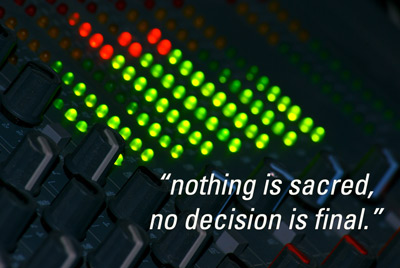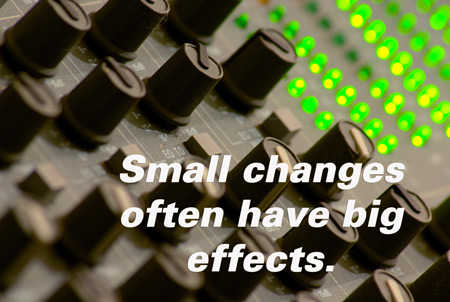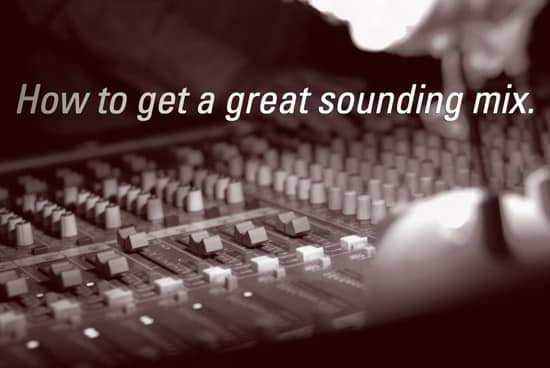When you’re first starting out, one of the biggest challenges can be your own self-doubt. Are you doing things the right way? Is your technique correct? Maybe you feel like you’re hitting your head against a brick wall?
We all experience this problem. Sometimes all you need is a little leg up to get your started. When people ask questions about music production on-line, because of the general dark art nature of music those with legitimate questions are often faced with an unhelpful reply of “aah, it’s far more complicated than that” or “you need tobe far more specific”. While those answers may well be technically true in any given case, it however doesn’t mean a more enlightened teacher wouldn’t be able to give more constructive advice by looking at what the person asking the question is trying to achieve, delving a little deeper into the query. The answer remains that there are many ways of achieving what you are seeking and ALL of them correct. More Often than not what would be of great benefit to the learner is sharing just one simple way of doing things, one point of view or process method as an example and starting point, from which you can start to build your knowledge up and gain some confidence. A process to practice can help develop your abilities along the long & sometimes frustrating road of music production.
So that’s what I intend to illustrate with this example, one way to start a mix down, Hey, maybe it’ll be the way that suits you best – you never know!
Firstly, are you Happy with the content and ideas, the song-writing and arrangement?
Before even considering doing a mix down and getting your song sounding good for public consumption you need to ask yourself a few questions. The biggest challenge of the modern era is the proliferation of technology and digital production! Yes, it has many benefits, I’ll admit, but the way it’s brought everything together has had one unmistakable downside. People overlap their jobs/processes. They mix while writing, they master while recording. This is the road to disaster! Complete Separation in your mind is very helpful between writing and making changes artistically, right through to deciding ‘right it’s done’… and – only after that’s completed – beginning to mix. Thinking only of the levels of the EQ and the relative sound is so important. Our brains are wonderful, but getting them to be artistic and outside-the-box at the same time as being Subjective and analytical is just a bit too much all at once for most people.
So…are you happy with this track? It may sound a little bit muffled and dirty, but is the idea there? Does it keep your attention? Most of all, does it have a solid artistic theme and idea? If so…. time to mix!
Zero All Faders
At this juncture I would always suggest a little housekeeping. After working on a project it’s inevitable that there will be a lot of clutter, muted tracks, surplus midi files here and there. Clear all that. If possible, organize your tracks into blocks where similar stuff is together. Basically, the idea is, when you’re mixing new ideas will form quickly in your head. You need to be able to grab faders and knobs as quickly as possible, as it’s important to try all these ideas out.
Rule Number 1 – It’s OK to have 10 different mix-downs, It is not a sign of indecision at this stage it actually gives you more options, so don’t be afraid to try every idea!
Now is also a good time to go through your tracks and work on some low and high Pass Filtering. Nothing audible though, you want to set you filters to get rid of any inaudible sound that could build up to clutter your mix, for example ultra-low frequency booms on a vocal.
At this point export a copy of your rough mix and import it into your project, muted.
Always start by dropping all the Faders to zero (infinity not unity gain). Music is very subjective, and if you continue to start your mix from the same start-point and just tweak around it, you can often get stuck in loops. Get out of the loops; if you end up with 10 completely different sounding mix downs that’s brilliant.

Start with the Kick
Let’s get going: Find your kick track; if you have multiple kicks layered in the song you should group them for easier control. Now bring that kick track up so your kick is peaking at no more than -12 on your meters. This may seem low, but trust me – this is how you get the best sound. (I would personally start even lower, at -18. It seems low on a digital system but that’s mostly down to bad design of digital metering and is more equivocal to mixing around unity gain on an analogue mixer).
At this stage It’s good to have a reference track actually in your project on a muted track that you can solo for quick comparison; also, match the level of the track to your working level from kick drum so you’ll be comparing around the same level of -12 to -18. It’s even better if you can find an un-mastered track as if you make a comparison against a mastered piece of work you’re hearing the added RMS and other processing that was used on the master. At this stage it would just complicate things.
Now, with only one track, we have our first judgement call, and it’s important… but by no means final –
Rule Number 2 – Never think your decision is final; if you think you need to change the kick then change it, …nothing is sacred in a mix down. It’s human nature to want to box things off as finished prematurely, but in reality you need to stay flexible right up to the very end.
Compare the kick to the comparison track you have set up. What we are looking for here is its general tone: does it have too much bass? too much high?not enough? Is it present enough in the 100-200 Hz area to give it that thwack we all know and love. Make any adjustments you think are needed here, do not worry about compression, stick to EQ, get it tonally balanced using your reference – this way you will get a good building block to start a mix around.
Snare or Clap – Find the prominent rhythm element
Next up, listen back to the rough copy of your mix you imported into to the project earlier. Identify the most important parts that drive the tune, the elements that give the track it’s rhythmical base. These are what we’re going to bring up first as they provide the basis for the energy that keeps the song moving. You need to get these important parts in early and build the rest around them, so they stay clear and powerful and don’t lose their impact as the song progresses.
Rule Number 3 – A technique really, for setting the rough level of your tracks. In this example let’s say [and to keep it simple]: the next track we are mixing in is the snare. Play your track and slowly bring up the snare until you feel it’s flowing well with your kick (or the other parts around it depending how far into your mix you are). Once you’re happy, this is your Low Point. Mark it or write it down, to remember it. Next put the Snare track really loud – so it’s obviously way too loud for your track – and begin to bring it down until you feel it’s sitting in the mix – that’s your High Point (also write down). Depending on the vibe and artistic vision for your song, any place in between these points should be viable as a mix level for you. So play about… do you want a dominating snare? – get it nearer the high point.
Balance
The aim of a good mix-down is to have all the elements clear and easily discernible (and enjoyable). Avoiding clashes and frequency masking, and sounding well balanced. This is why it’s good to separate this process / technical work from the artistic work. People often ruin their mixes by trying to impart their emotions into the actual levels of the sound e.g. “I want the kick to be huge” so it ends up far too loud. We’ve all been there! It’s just one of the many pitfalls in this business, solutions are never quite so simple.
Follow this same procedure, bringing the most important tracks for the musical flow and drive of the track first, keeping the bass-line back for now. Once you have brought up each of the tracks and worked out a nice level for it to sit at, you’ll start to hear a generally well-balanced mix. If you find you bring up a track and are not really happy with how it sounds at its ‘correct’ level, then pull out the EQ see if it’s the actual balance of the sound in terms of frequencies. Compare all the time to your un-mastered track, this is where it is really useful. Don’t worry about your overall mix level yet. Pick out similar but nicely mixed sounds to compare your problem ones to and think how you can match their tone. Also spend some time thinking about the Attack to Body ratio of your sounds: the Attack is the immediate whack of the sound, the Body being the tail behind it. This is so important when it comes to getting a chunky sound, and a clear and concise groove. Too much attack on too many of your percussive sounds can cause your groove to trip, and not flow freely, whilst too much body can also bog you down. Use Compressors and other dynamic tools to control and adjust these elements.
The Bass line should be brought in near the end, although it’s one of the most important tracks in the song, for this technique I think it’s better to get your drums in place first and then bring the bass in and make it fit around your drums rather than cut into them. So use EQ and your envelopes to fit the bass line with the rhythm established by your mixed drums. Cut away where the kick is most prominent, and balance the sub of the bass so it works well with the track. Using some subtle (read hardly hear-able) distortion on your bass track can also provide some much appreciated upper harmonics that will allow it to sit a lot better in your mix.
Rule Number 4 – When working with digital tools, and hardware ones… it’s easy to overdo it. Making massive changes when it’s possible a small tweak is all you need is a common mistake. Make sure when you’re working technically – as we are now in the mix down – you are not boosting or cutting your EQ more than a few DB. If you work where it matters most a single DB can often make all the difference. The same advice applies for Compressors: if you are smashing your sound for 9DB, be aware that you are in the realms of working artistically not technically. So get all your artistic FX work out of the way before you start the mix-down.

Mutes
Now you have every track in, you have set the volume sitting where we can hear it, but still some things clash a little – what’s going on?
What’s happening here is: however forward thinking you are as a producer, you will tend to pack in more ideas than you need, so at this point take a scan of the song. Listen through a few times looking for parts which play at the same time in the same frequencies, or parts which clash rhythmically. Note down everything that takes away from the feel of the song, be bold! Sometimes muting the part you love the most in the main section can turn an ok song into a classic.
Experiment with muting the problem tracks. You can work with relative EQ changes to some parts to make them fit by taking some frequency from one clashing part and adding the same frequency to the other. This stage is most important as it also works at making your music more concise and direct. This also makes it more powerful and memorable.
It’s important at this stage to also think about Panning, so think of your arrangement as a 3-D space. If two of the main instruments play at the same time in the center, maybe they shouldn’t both be sat there! By Panning things a little bit we can help people understand your mix a lot better. Human ears are very good at picking out directional data, so you can often sort out a frequency clash by changing where the sounds are coming from in the stereo field.
Basic Mix Complete
At this stage you should be getting close to a basic but great sounding & balanced mix. Don’t even think about volume yet. Mastering is a whole different game and should receive the same separation in thought and process as your mix-down. Once you are happy with your basic mix, and this shouldn’t have taken you too long at all, trust your first instincts in the mix as you can always go back and change things. Now is the time to think about any things you may wish to embellish. Think about your use of reverb and modulation to add texture and depth to the production. Think about the rhythmic clarity, and the percussive balance of your track. From this point onward there really are no rules, but the main rule is:
Rule Number 5 – Small changes = Big Effects!
Don’t overdo it, be respectfully careful. You have created the artistic work, you have the solid mix-down, now don’t throw it all away by over-doing what should be merely a series of small, amazing… inspired tweaks. Experimentation once again is the key, as these trial and error adjustments can’t be taught.
So there you have it! One Way to Get a mix-down done. But wait…there’s one ultimate rule:
Rule Number 6 – If you’re not happy…. zero the faders… start again. From 0 to a basic mix down should take you no longer than 30 minutes to an hour once you get the hang of it. It’s the small touches and tweaking that takes forever.
And remember this is only one way of doing things, there are many other and some completely opposite ways of doing things. If you follow this, learn it and get used to it, you will develop that basic knowledge and confidence to really start playing around.

